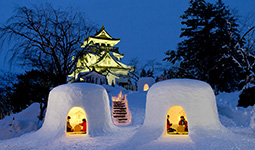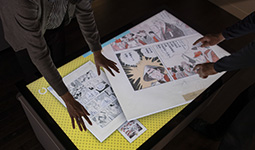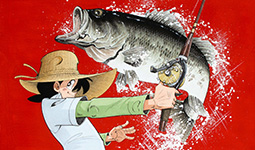INDEX
- English
- 日本語

Yokote Masuda Manga Museum - English
- 日本語

Activities at Tsurikichi Sampei no Sato

Manga artwork on display at the museum 
Kamakura snow houses during the Yokote Snow Festival 
A large touch-panel screen allows visitors to view scanned original drawings 
Tsurikichi Sampei
December 2020
A Town Blessed with Nature and Tradition—and a Manga Museum

The city of Yokote in Akita Prefecture is well known for its traditional kamakura (snow house) event and its signature style of stir-fried noodles. Recently, a pioneering manga-themed museum has also been attracting attention.

Located in a basin surrounded by mountains, the city of Yokote in Akita Prefecture is blessed with abundant nature and a traditional culture unique to one of the “especially heavy snowfall regions” of Japan. In particular, the Kamakura Festival is a well-known event with a history spanning more than 450 years. Kamakura are small houses made of snow. In the traditional event of the same name a water god was believed to be enshrined in the kamakura, where children had fun baking and eating mochi rice cakes and drinking amazake, a sweet beverage made from rice. The event evolved to become the Yokote Snow Festival, which is held in mid-February, when more than a hundred large and small kamakura snow houses are built in the city, drawing many tourists every year. Visitors can enter the snow houses and enjoy traditional foods such as the aforementioned mochi and amazake. For those who cannot visit at the time of the festival, the Yokote Fureai Center Kamakura Hall displays a kamakura snow house year-round in a room permanently kept at about -10°C.

The town of Masuda within Yokote City was for centuries a thriving commercial center where rice, leaf tobacco, raw silk and many other commodities were traded. A number of old homes and storehouses built between the mid-nineteenth and mid-twentieth century still stand here and have been designated by the national government as an Important Preservation District for Groups of Traditional Buildings.
In Masuda, the Yokote Masuda Manga Museum opened in 1995. The museum typically attracts over 100,000 visitors from Japan and abroad every year. Recognized as a base for the promotion of cultural tourism by the Agency for Cultural Affairs of the Japanese Government, the museum is at the core of efforts to promote local cultural tourism.
The museum opened with the underlying objective of celebrating the achievements of Yaguchi Takao, a popular manga artist who was born in Yokote. Yaguchi created numerous works, most notably Tsurikichi Sampei, before his death in November 2020. Tsurikichi Sampei is the story of a boy named Sampei traveling Japan and the world to fish. It was serialized in a comic magazine for boys for nearly ten years from 1973 until 1983, and played a role in popularizing angling nationwide.

“Initially, the plan was to build a memorial museum to exhibit the works of Masuda native Yaguchi Takao, but he suggested that it should be designed to widely disseminate the wonderful Japanese manga culture to the world. Based on this suggestion, we adjusted the plan to create this manga museum,” says Shibata Toshinori of the Yokote City Planning Department’s Culture Promotion Division.
Visitors are welcome to read as many of the museum’s roughly 25,000 manga volumes as they like. The museum also keeps an enormous number of original drawings, so-called genga, in storage. After two years of renovation, the museum reopened in May 2019 and currently possesses more than 400,000 pieces of genga by 181 manga artists, including Yaguchi and many others from Japan and other Asian countries. Three to four genga representing each of seventy-four manga artists from the museum’s collection are exhibited at all times and are rotated on a regular basis on the wall of a gentle slope extending from the first floor to the second floor of the museum and in the exhibition room on the second floor.

“In the past, the original artwork for manga was used to print the book or magazine, and once the printing was finished, it was no longer needed. But look at the drawings up close. Everyone would be impressed by the real, compelling strokes, just like in other forms of art. We ensure that these great drawings are preserved for posterity, and not scattered and lost like ukiyo-e prints and the woodblocks that were used to make them. This is the important role we play,” Shibata explains.
The museum is also committed to digitally archiving the genga. Visitors can view the digital archive freely using the large touch panels inside the building. They can also see the ongoing preservation work conducted in a glass-walled storage room.

Beyond the manga he is famous for, Yaguchi drew beautiful pictures of the nature and landscapes of Yokote. Seeing these pictures up close is one of the opportunities fans look forward to. A ten-minute drive from the museum takes the visitor to Tsurikichi Sampei no Sato (Tsurikichi Sampei’s hometown), a recreation facility themed on the work of Yaguchi. Here fishing, walking, barbecuing in summer and winter activities such as skiing can be enjoyed, surrounded by the beauty of nature that has remained unchanged through the ages.
The city of Yokote has a flourishing agricultural sector, growing rice, apples, grapes, cherries, watermelon and many other fruits. Yokote is also well-known for its Yokote Yakisoba, a dish of stir-fried noodles, pork and cabbage, topped with a fried egg sunny-side up, and served with fukujinzuke pickled vegetables. Yokote Yakisoba is a beloved local cuisine that is known nationwide. As Yaguchi Takao would no doubt agree, a trip to Yokote would not be complete without tasting this unique local food.

